Seat Ibiza 5D 2005 Owner's manual
Manufacturer: SEAT, Model Year: 2005, Model line: Ibiza 5D, Model: Seat Ibiza 5D 2005Pages: 252, PDF Size: 7.56 MB
Page 221 of 252
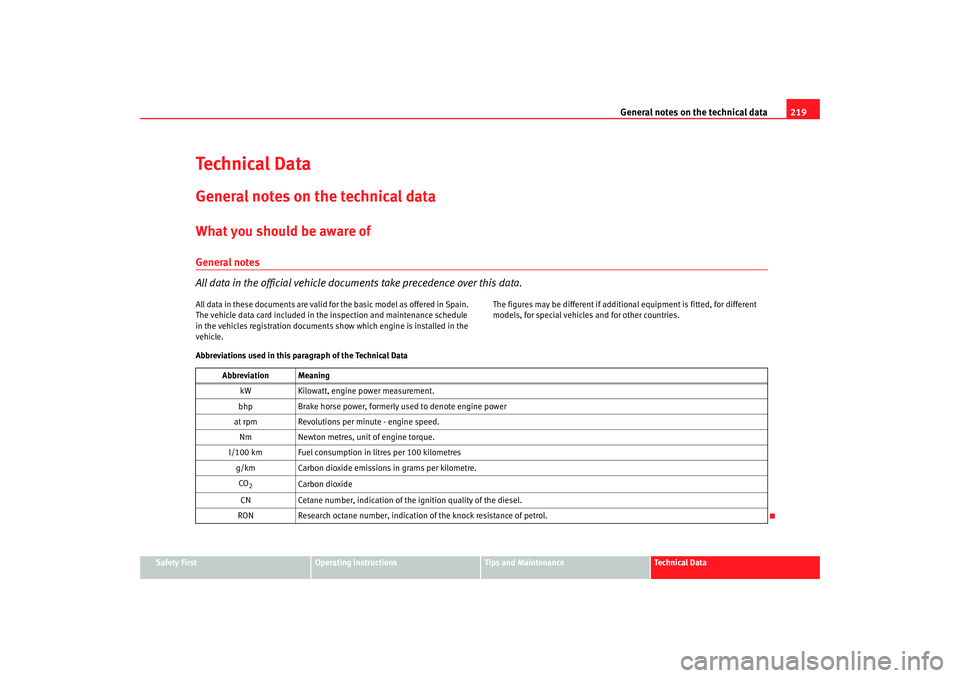
General notes on the technical data 219
Safety First
Operating instructions
Tips and Maintenance
Te c h n i c a l D a t a
Te c h n i c a l D a t aGeneral notes on the technical dataWhat you should be aware ofGeneral notes
All data in the official vehicle documents take precedence over this data.All data in these documents are valid for the basic model as offered in Spain.
The vehicle data card included in the inspection and maintenance schedule
in the vehicles registration documents show which engine is installed in the
vehicle. The figures may be different if addition
al equipment is fitted, for different
models, for special vehicles and for other countries.
Abbreviations used in this paragraph of the Technical Data Abbreviation MeaningkW Kilowatt, engine power measurement.
bhp Brake horse power, formerly used to denote engine power
at rpm Revolutions per minute - engine speed. Nm Newton metres, unit of engine torque.
l/100 km Fuel consumption in litres per 100 kilometres g/km Carbon dioxide emission s in grams per kilometre.
CO
2
Carbon dioxide
CN Cetane number, indication of the ignition quality of the diesel.
RON Research octane number, indication of the knock resistance of petrol.
ibiza_ingles Seite 219 Mittwoch, 5. Oktober 2005 5:17 17
Page 222 of 252
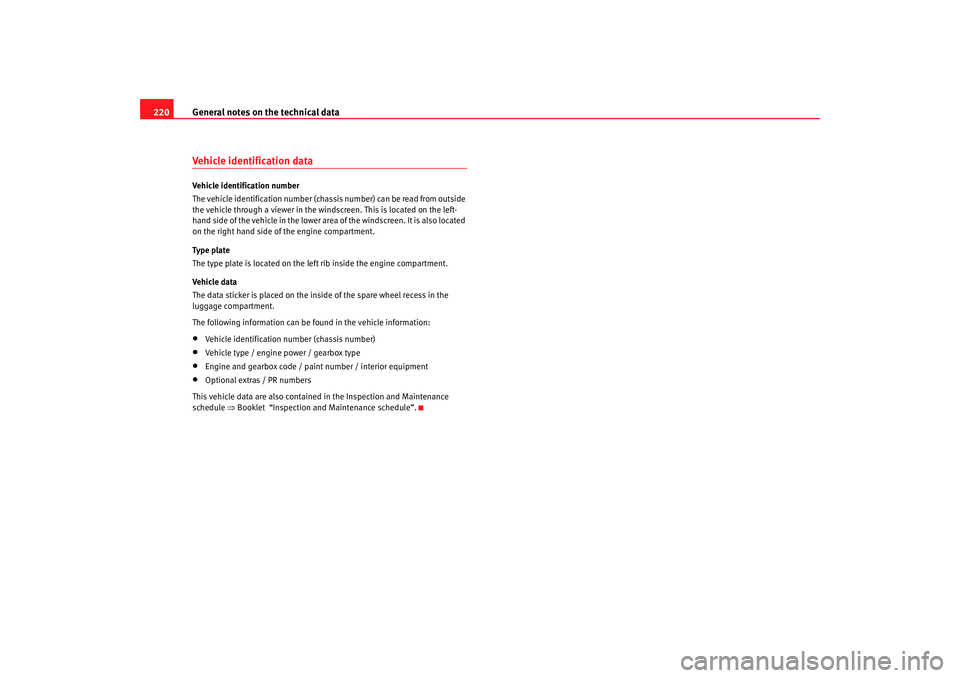
General notes on the technical data
220Vehicle identification dataVehicle identification number
The vehicle identification number (chass is number) can be read from outside
the vehicle through a viewer in the windscreen. This is located on the left-
hand side of the vehicle in the lower area of the windscreen. It is also located
on the right hand side of the engine compartment.
Type plate
The type plate is located on the left rib inside the engine compartment.
Vehicle data
The data sticker is placed on the inside of the spare wheel recess in the
luggage compartment.
The following information can be found in the vehicle information:•
Vehicle identification number (chassis number)
•
Vehicle type / engine power / gearbox type
•
Engine and gearbox code / paint number / interior equipment
•
Optional extras / PR numbers
This vehicle data are also contained in the Inspection and Maintenance
schedule ⇒ Booklet “Inspection and Maintenance schedule”.
ibiza_ingles Seite 220 Mittwoch, 5. Oktober 2005 5:17 17
Page 223 of 252
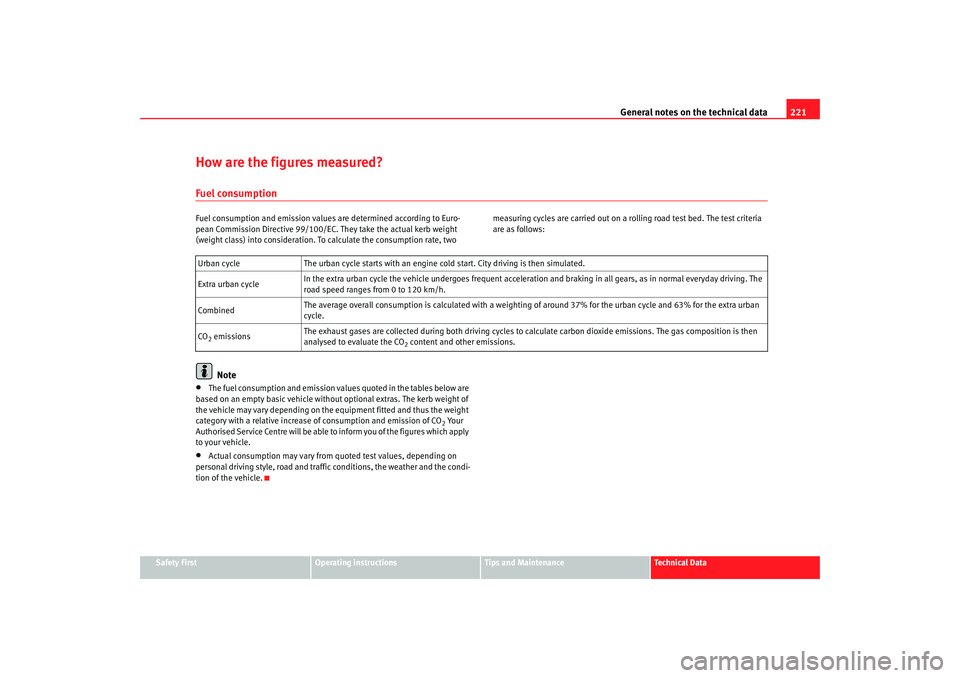
General notes on the technical data 221
Safety First
Operating instructions
Tips and Maintenance
Te c h n i c a l D a t a
How are the figures measured?Fuel consumptionFuel consumption and emission values are determined according to Euro-
pean Commission Directive 99/100/EC. They take the actual kerb weight
(weight class) into consideration. To calculate the consumption rate, two measuring cycles are carried out on a rolling road test bed. The test criteria
are as follows:
Note
•
The fuel consumption and emission values quoted in the tables below are
based on an empty basic vehicle without optional extras. The kerb weight of
the vehicle may vary depending on the equipment fitted and thus the weight
category with a relative increase of consumption and emission of CO
2 Your
Authorised Service Centre will be able to inform you of the figures which apply
to your vehicle.
•
Actual consumption may vary from quoted test values, depending on
personal driving style, road and traffic conditions, the weather and the condi-
tion of the vehicle. Urban cycle
The urban cycle starts with an engine cold start. City driving is then simulated.
Extra urban cycle In the extra urban cycle the vehicle undergoes frequent acceleration
and braking in all gears, as in normal everyday driving. The
road speed ranges from 0 to 120 km/h.
Combined The average overall consumption is calculat
ed with a weighting of around 37% for the urban cycle and 63% for the extra urban
cycle.
CO2 emissions The exhaust gases are collected during both driving cycles to calculate carbon dioxide emissions. The gas composition is then
analysed to evaluate the CO
2 content and other emissions.
ibiza_ingles Seite 221 Mittwoch, 5. Oktober 2005 5:17 17
Page 224 of 252
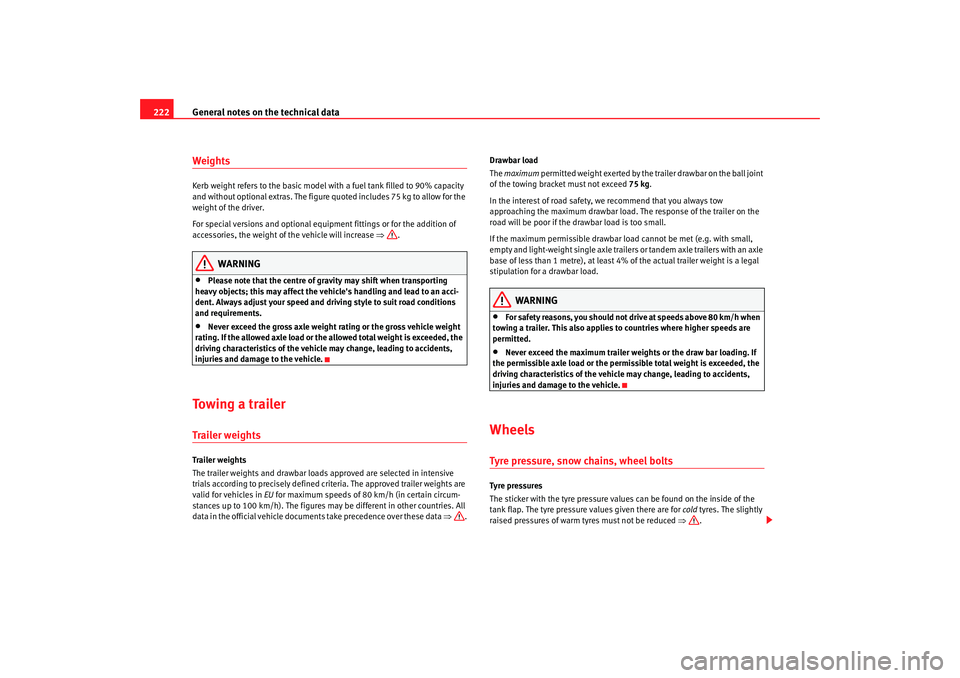
General notes on the technical data
222WeightsKerb weight refers to the basic model with a fuel tank filled to 90% capacity
and without optional extras. The figure quoted includes 75 kg to allow for the
weight of the driver.
For special versions and optional equipment fittings or for the addition of
accessories, the weight of the vehicle will increase ⇒.
WARNING
•
Please note that the centre of gravity may shift when transporting
heavy objects; this may affect the vehi cle's handling and lead to an acci-
dent. Always adjust your speed and dr iving style to suit road conditions
and requirements.
•
Never exceed the gross axle weight rating or the gross vehicle weight
rating. If the allowed axle load or the allowed total weight is exceeded, the
driving characteristics of the vehicle may change, leading to accidents,
injuries and damage to the vehicle.
To w i n g a t r a i l e rTrailer weightsTrailer weights
The trailer weights and drawbar loads approved are selected in intensive
trials according to precisely defined criteria. The approved trailer weights are
valid for vehicles in EU for maximum speeds of 80 km/h (in certain circum-
stances up to 100 km/h). The figures may be different in other countries. All
data in the official vehicle documents take precedence over these data ⇒. Drawbar load
The
maximum permitted weight exerted by the trailer drawbar on the ball joint
of the towing bracket must not exceed 75 kg.
In the interest of road safety, we recommend that you always tow
approaching the maximum drawbar load. The response of the trailer on the
road will be poor if th e drawbar load is too small.
If the maximum permissible drawbar load cannot be met (e.g. with small,
empty and light-weight single axle trailers or tandem axle trailers with an axle
base of less than 1 metre), at least 4% of the actual trailer weight is a legal
stipulation for a drawbar load.
WARNING
•
For safety reasons, you should not drive at speeds above 80 km/h when
towing a trailer. This also applies to countries where higher speeds are
permitted.
•
Never exceed the maximum trailer weights or the draw bar loading. If
the permissible axle load or the perm issible total weight is exceeded, the
driving characteristics of the vehicle may change, leading to accidents,
injuries and damage to the vehicle.
WheelsTyre pressure, snow chains, wheel boltsTyre pressures
The sticker with the tyre pressure values can be found on the inside of the
tank flap. The tyre pressure values given there are for cold tyres. The slightly
raised pressures of warm tyres must not be reduced ⇒.
ibiza_ingles Seite 222 Mittwoch, 5. Oktober 2005 5:17 17
Page 225 of 252
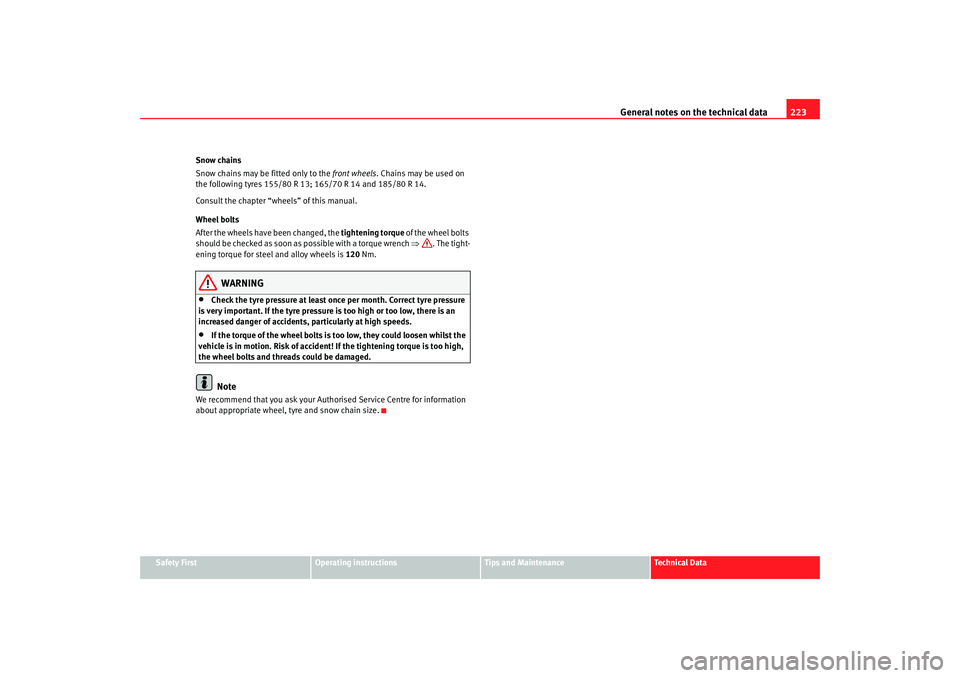
General notes on the technical data 223
Safety First
Operating instructions
Tips and Maintenance
Te c h n i c a l D a t a
Snow chains
Snow chains may be fitted only to the
front wheels. Chains may be used on
the following tyres 155/80 R 13; 165/70 R 14 and 185/80 R 14.
Consult the chapter “wheels” of this manual.
Wheel bolts
After the wheels have been changed, the tightening torque of the wheel bolts
should be checked as soon as possible with a torque wrench ⇒. The tight-
ening torque for steel and alloy wheels is 120 Nm.
WARNING
•
Check the tyre pressure at least once per month. Correct tyre pressure
is very important. If the tyre pressure is too high or too low, there is an
increased danger of accidents, particularly at high speeds.
•
If the torque of the wheel bolts is too low, they could loosen whilst the
vehicle is in motion. Risk of accident! If the tightening torque is too high,
the wheel bolts and threads could be damaged.Note
We recommend that you ask your Authorised Service Centre for information
about appropriate wheel, tyre and snow chain size.
ibiza_ingles Seite 223 Mittwoch, 5. Oktober 2005 5:17 17
Page 226 of 252
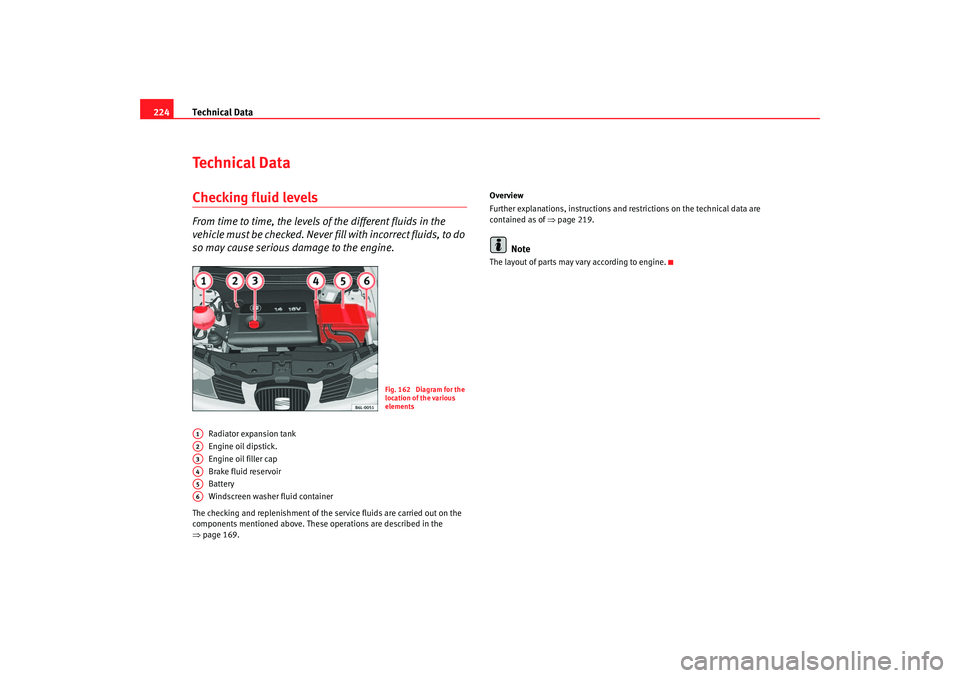
Technical Data
224Te c h n i c a l D a t aChecking fluid levelsFrom time to time, the levels of the different fluids in the
vehicle must be checked. Never fi ll with incorrect fluids, to do
so may cause serious damage to the engine.
Radiator expansion tank
Engine oil dipstick.
Engine oil filler cap
Brake fluid reservoir
Battery
Windscreen washer fluid container
The checking and replenishment of the service fluids are carried out on the
components mentioned above. These operations are described in the
⇒ page 169. Overview
Further explanations, instructions and restrictions on the technical data are
contained as
of ⇒ page 219.
Note
The layout of parts may vary according to engine.
Fig. 162 Diagram for the
location of the various
elements
A1A2A3A4A5A6
ibiza_ingles Seite 224 Mittwoch, 5. Oktober 2005 5:17 17
Page 227 of 252
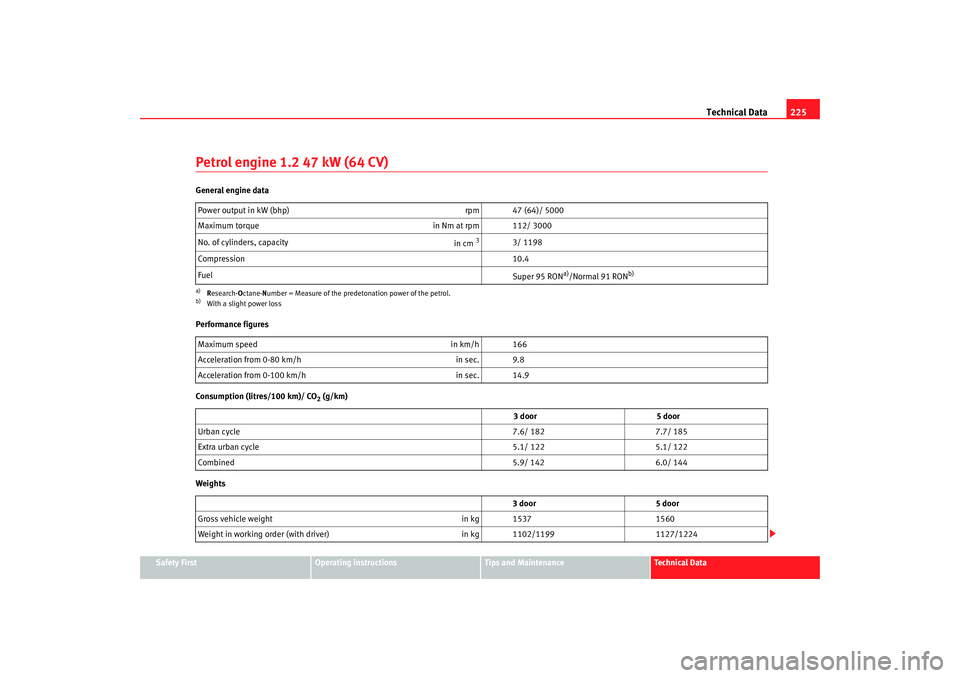
Technical Data225
Safety First
Operating instructions
Tips and Maintenance
Te c h n i c a l D a t a
Petrol engine 1.2 47 kW (64 CV)General engine data
Performance figures
Consumption (litres/100 km)/ CO
2 (g/km)
Weights Power output in kW (bhp)
rpm 47 (64)/ 5000
Maximum torque in Nm at rpm 112/ 3000
No. of cylinders, capacity in cm
3
3/ 1198
Compression 10.4
Fuel Super 95 RON
a)/Normal 91 RON
b)
a)Research-O ctane-Number = Mea sure of the pr
edetonation power of the petrol.
b)With a slight power lossMaximum speed in km/h 166
Acceleration from 0-80 km/h in sec. 9.8
Acceleration from 0-100 km/h in sec. 14.9
3 door 5 door
Urban cycle 7.6/ 182 7.7/ 185
Extra urban cycle 5.1/ 122 5.1/ 122
Combined 5.9/ 142 6.0/ 144
3 door 5 door
Gross vehicle weight in kg 15371560
Weight in working order (with driver) in kg 1102/11991127/1224
ibiza_ingles Seite 225 Mittwoch, 5. Oktober 2005 5:17 17
Page 228 of 252
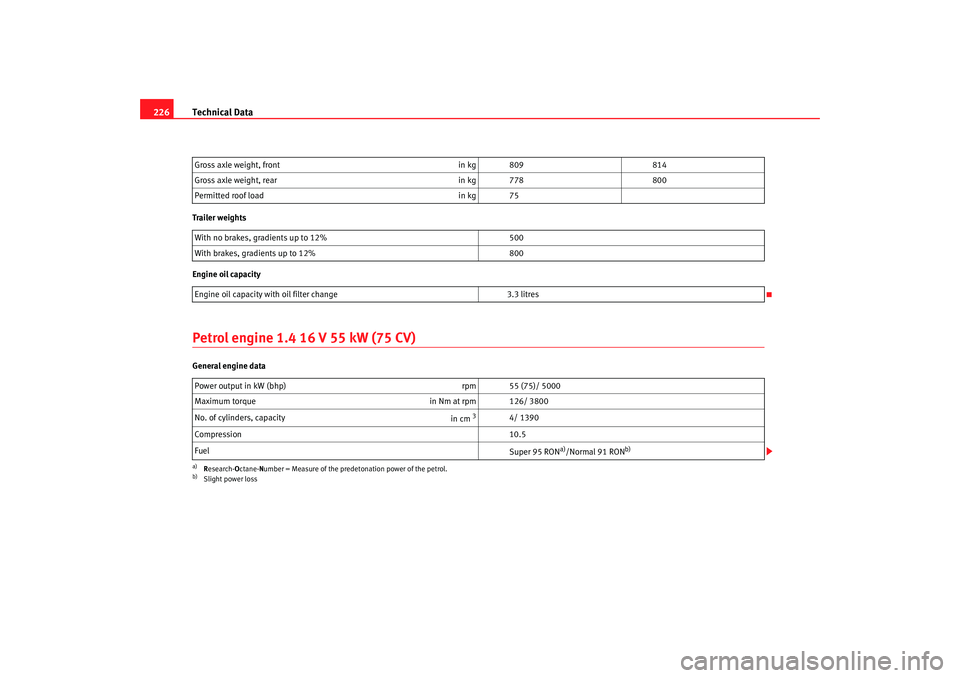
Technical Data
226Trailer weights
Engine oil capacityPetrol engine 1.4 16 V 55 kW (75 CV)General engine data Gross axle weight, front
in kg 809814
Gross axle weight, rear in kg 778800
Permitted roof load in kg 75
With no brakes, gradients up to 12% 500
With brakes, gradients up to 12% 800
Engine oil capaci ty with oil filter change 3.3 litres
Power output in kW (bhp) rpm 55 (75)/ 5000
Maximum torque in Nm at rpm 126/ 3800
No. of cylinders, capacity in cm
3
4/ 1390
Compre ssion 10.5
Fuel Super 95 RON
a)/Normal 91 RON
b)
a)Research-Octane-Number = Measure of the predetonation power of the petrol.b)Slight power loss
ibiza_ingles Seite 226 Mittwoch, 5. Oktober 2005 5:17 17
Page 229 of 252
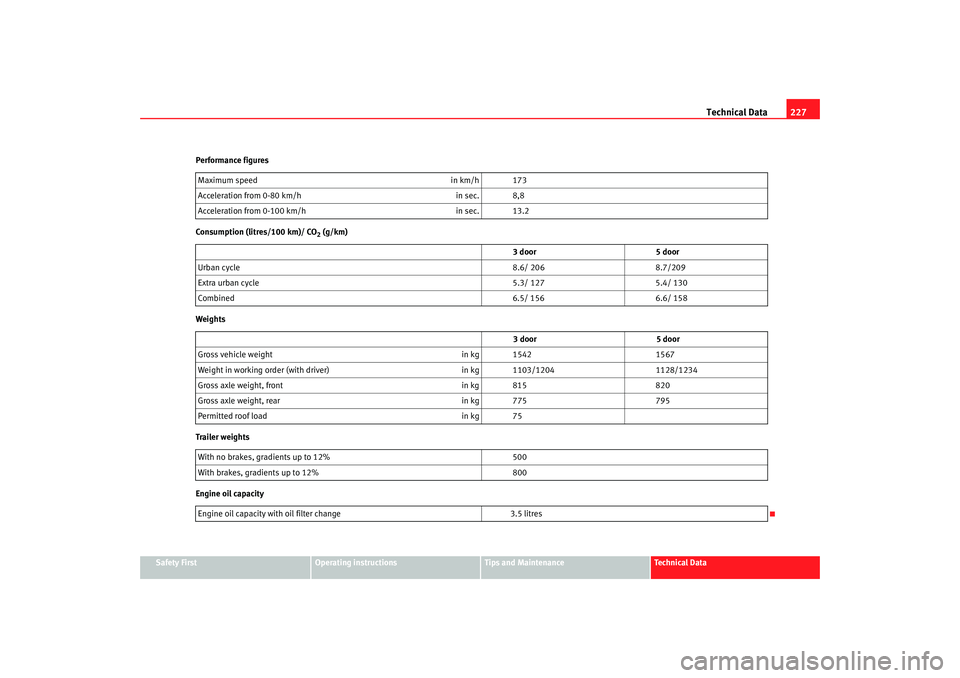
Technical Data227
Safety First
Operating instructions
Tips and Maintenance
Te c h n i c a l D a t a
Performance figures
Consumption (litres/100 km)/ CO
2 (g/km)
Weights
Trailer weights
Engine oil capacity Maximum speed
in km/h 173
Acceleration from 0-80 km/h in sec. 8,8
Acceleration from 0-100 km/h in sec. 13.2
3 door 5 door
Urban cycle 8.6/ 206 8.7/209
Extra urban cycle 5.3/ 127 5.4/ 130
Combined 6.5/ 156 6.6/ 158
3 door 5 door
Gross vehicle weight in kg 15421567
Weight in working order (with driver) in kg 1103/12041128/1234
Gross axle weight, front in kg 815820
Gross axle weight, rear in kg 775795
Permitted roof load in kg 75
With no brakes, gradients up to 12% 500
With brakes, gradients up to 12% 800
Engine oil capacity with oil filter change 3.5 litres
ibiza_ingles Seite 227 Mittwoch, 5. Oktober 2005 5:17 17
Page 230 of 252
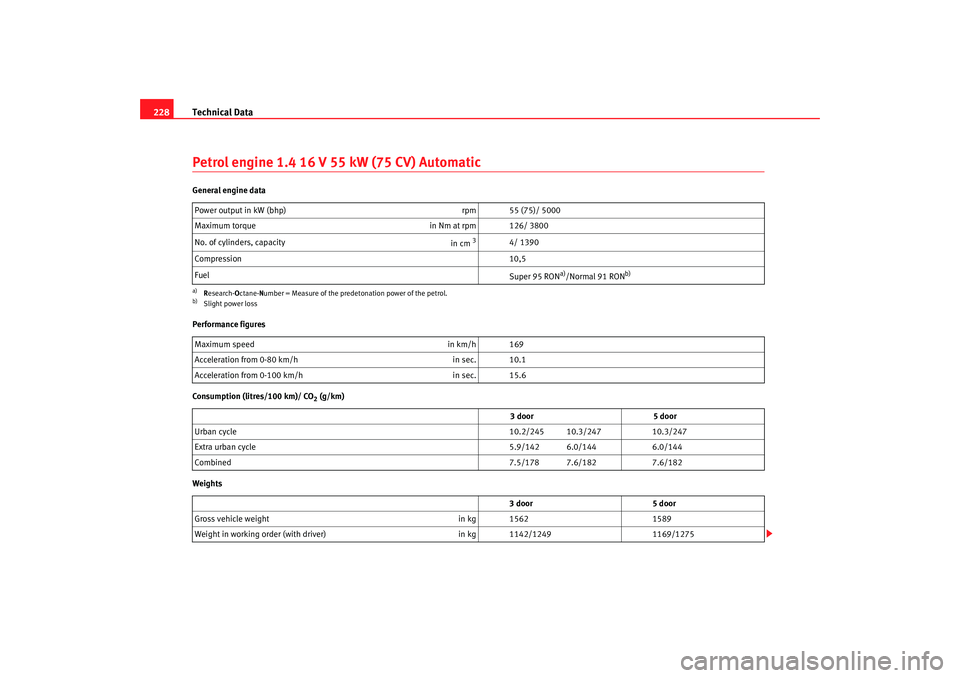
Technical Data
228Petrol engine 1.4 16 V 55 kW (75 CV) AutomaticGeneral engine data
Performance figures
Consumption (litres/100 km)/ CO
2 (g/km)
Weights Power output in kW (bhp)
rpm 55 (75)/ 5000
Maximum torque in Nm at rpm 126/ 3800
No. of cylinders, capacity in cm
3
4/ 1390
Compression 10,5
Fuel Super 95 RON
a)/Normal 91 RON
b)
a)Resear ch-Octane-N um
ber = Measure of the p redetonation power of the pet rol.
b)Slight power lossMaximum speed in km/h 169
Accelera tion from 0-80 km/h in sec. 10.1
Accelera tion from 0-100 km/h in sec. 15.6
3 door 5 door
Urban cycle 10.2/245 10.3/247 10.3/247
Extra urban cycle 5.9/142 6.0/144 6.0/144
Combined 7.5/178 7.6/182 7.6/182
3 door 5 door
Gross vehicle weight in kg 15621589
Weight in working order (with driver) in kg 1142/12491169/1275
ibiza_ingles Seite 228 Mittwoch, 5. Oktober 2005 5:17 17